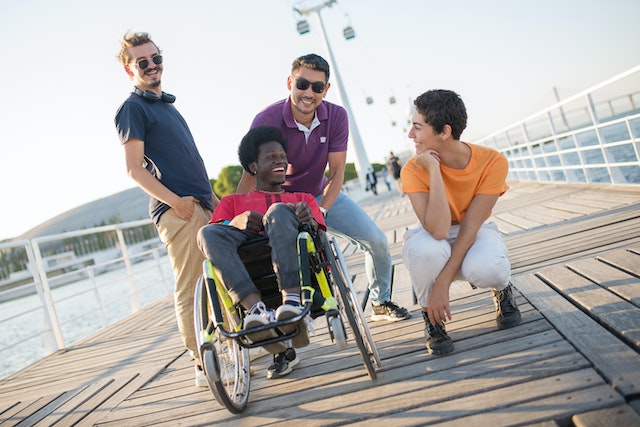We’re at a point in time where advocating for minority groups is more important than ever before. Most people want to be a part of the solution but don’t have a good idea on where to get started. If you’re wanting to advocate for people with disabilities and be an ally to the disability community, here are some great ways to get started.
Why You Should Advocate for People with Disabilities:
It is important to advocate for people with disabilities and be an ally to the disability community because these individuals very often rely on able bodied individuals without disabilities to help them access and navigate the world around them. While accessibility and navigation are becoming easier and easier for the disability community, it’s still a slow moving process and often times businesses/cities aren’t setup to be accessible and these individuals need help from non-disabled individuals to access their communities.
The goal is always for individuals with disabilities to have as much independence as possible and not need to rely on other people to help them access the things they need. As non-disabled individuals partner alongside the disability community and help advocate for their needs, it helps to further the work to make the world a more accessible and inclusive space.

How to Advocate for People with Disabilities:
Here are 7 ways you can be an advocate and an ally to individuals with disabilities. We hope for these to be easy and practical things that you can easily incorporate into your everyday life.
Get to Know Them and Their Interests:
If you see an individual with a disability while you’re out in the community and it’s practical to do so, take the time to get to know them. Find out what their interests are, what they enjoy, and what they’re planning on doing that day. Taking the time to get outside yourself and learn about someone else is the best way to begin to be an ally.
Follow Influencers with Disabilities and Share their Content/Opinions:
With so much of our daily interactions being online, take the time to diversify your social media accounts with individuals with disabilities whose opinions and life experiences likely differ from your own. Here are some great individuals to follow:
- KerryMagro: Shares his lived experiences as an individual with Autism.
- Jordapraxia: Talks about his journey with apraxia and how he’s navigated his speech throughout his life, and helps to break the stigma around speech disorders.
- Crutches_and_Spice: An amazing disability advocate who has physical disabilities and tells it like it is!
- DisabilityReframed: Speaks about common misconceptions and ablest language that impacts the disability community.
- ShaneBurcaw: Shane has Spinal Muscular Atrophy, and shares all about his life living with a disability that has impacted him in a lot of different ways. He’s written books, done public speaking engagements, and has a youtube channel with his wife, Hannah.
- Aaronwheelz: Is a wheelchair BMX athlete (commonly known as WMX), who has done a lot of good at representing the strength, determination, and ability of disabled athletes and the impact they have in the world. Hot Wheels even released a collection of WMX wheelie chairs in honor of Aaron!

Listen to What They Have to Say:
Take the time to really listen to what these individuals are saying. Whether that is online or in an active conversation. Don’t be quick to jump in and dismiss their concerns. Look them in the eyes, hear their concerns, ask follow up questions. Give them the time, respect, and curtesy for their voice to be heard.
Promote Accessibility in Your Home/Community:
Is your own home accessible for a wheelchair user? Are there things you can easily do to make your home more accessible? Can you add a portable wheelchair ramp to your own garage so there is at least one accessible entry point?
Are there businesses in your town that aren’t accessible? Do they have steps into the building with no available ramps? Take the time to talk to these business owners and encourage them to make their buildings more accessible. Businesses can actually write off accessibility modifications on their taxes and receive a tax credit, so it’s in their interest to do the work if needed.
Respect Their Autonomy:
When you think of being an ally to the disability community you might want to jump in and help them do something whenever possible. This is not the best practice. If someone with a disability is trying to do something, let them do it on their own, even if it takes longer than if you had just helped them. Most individuals want the autonomy to do something on their own. If you see someone who is struggling to do something and you feel compelled to help, ask first. See if they truly need/want the help and then if they accept, you can intervene and do the act of service for them. It is always best though to assume competence and ask first instead of jumping in and fixing the problem without asking.

Fight Against Discrimination:
Sometimes the best work you can do for individuals with disabilities might be more behind the scenes. If you hear someone saying slurs about disabled individuals, commit to speaking up and calling that person out for the things they’re saying. If you see someone actively being discriminated against in public, stand with that individual and help them get the resources they need to be successful. Commit to being someone who actively engages to solve the problem instead of staying quiet and passively watching something happen.
Use Inclusive Language:
Use inclusive language for individuals with disabilities. Don’t use negative slurs in your own speech and writing. Learn about what common phrases in everyday speech are actually negative connotations for individuals with disabilities. Actively commit to removing those words from your own vocabulary. We wrote an entire post about inclusive language that you can see here.






